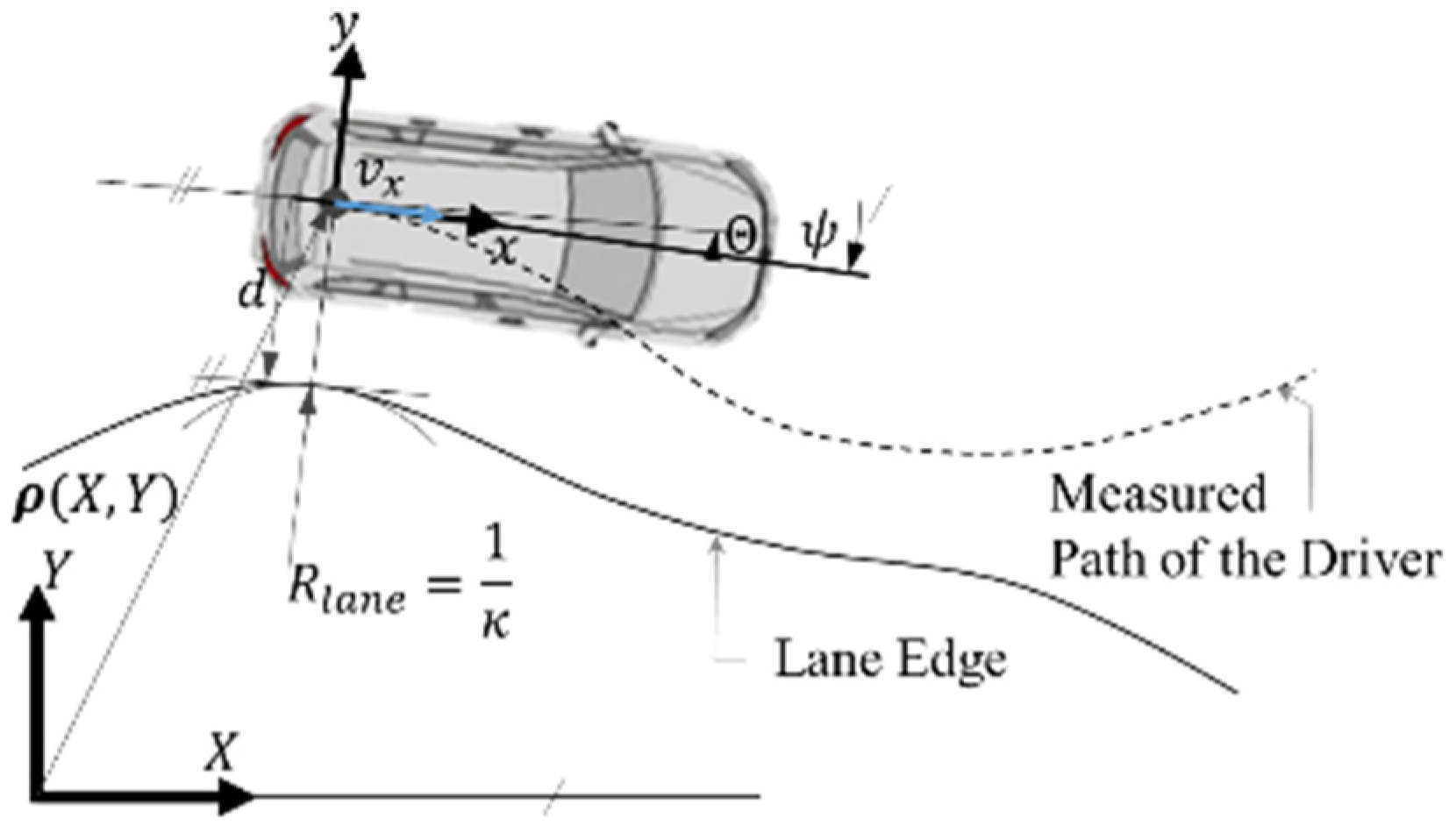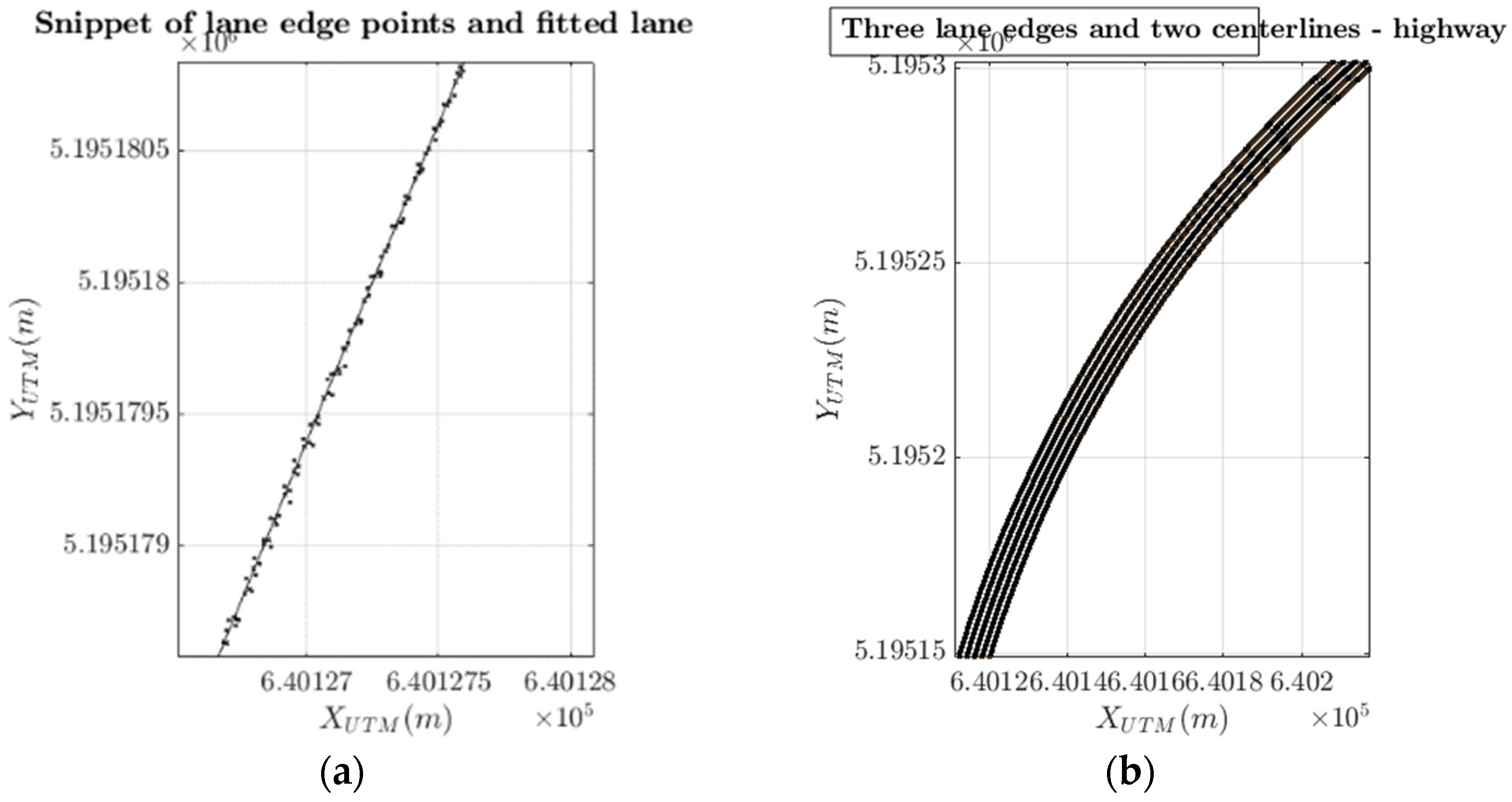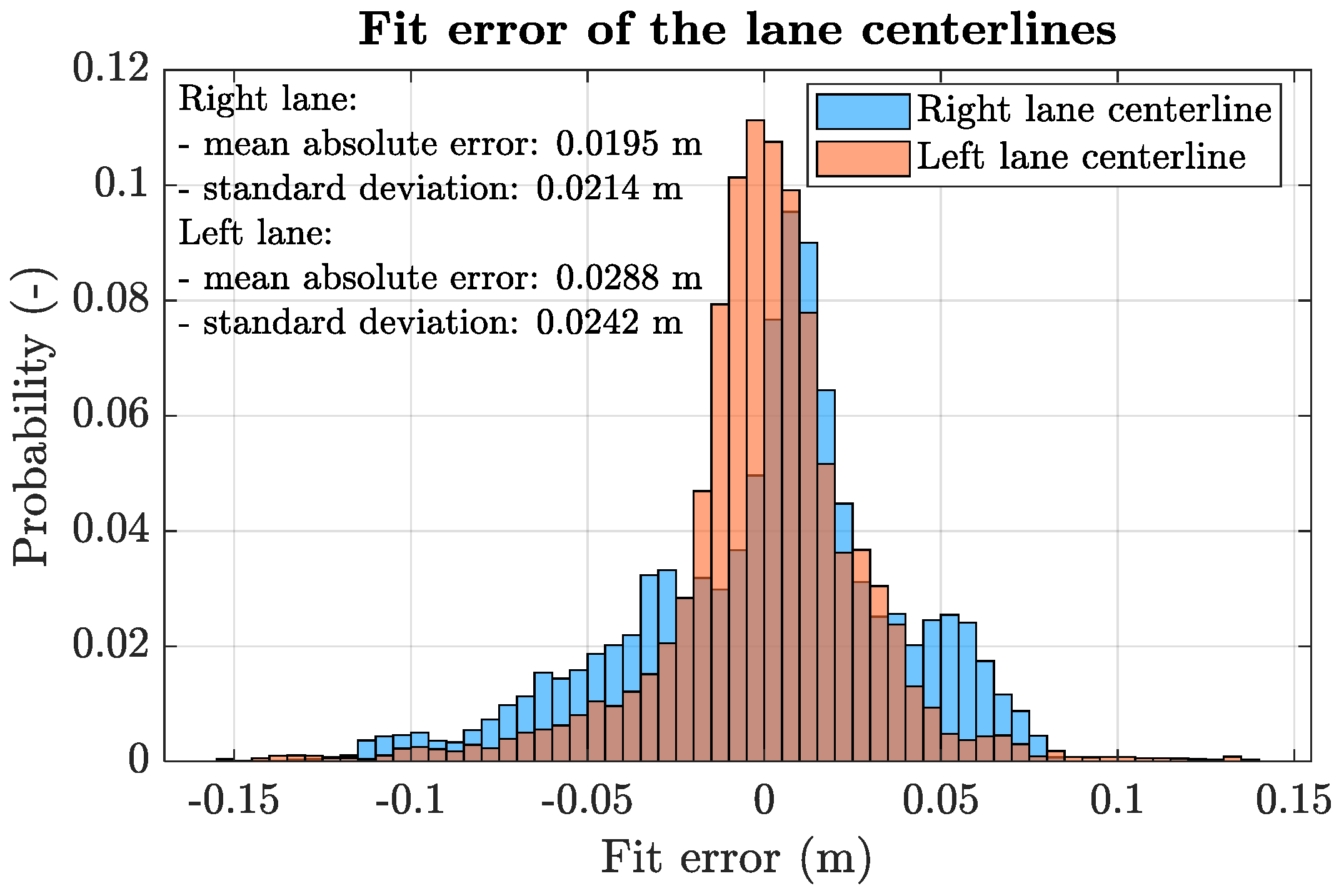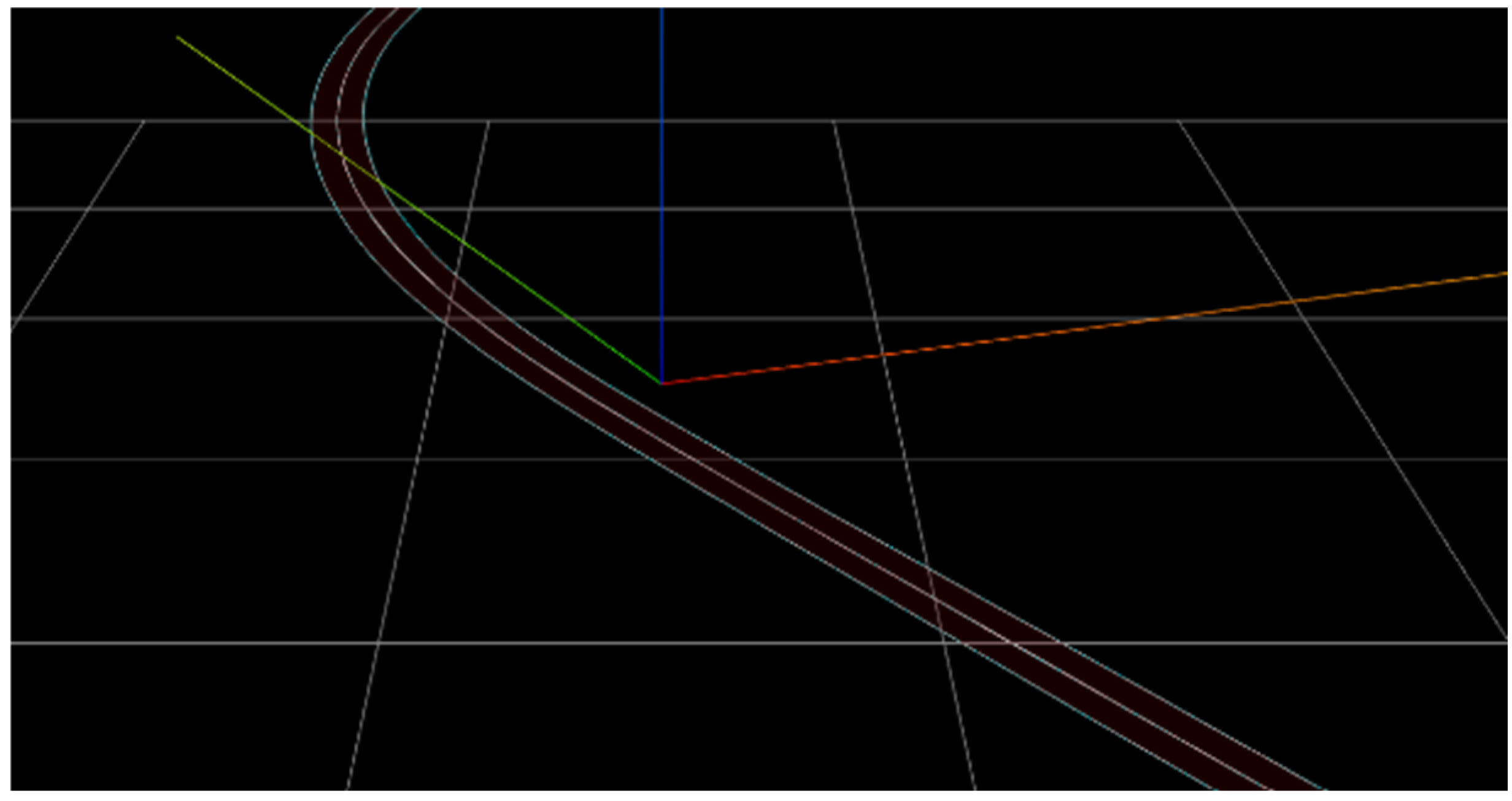Lightweight Solution to Generate Accurate Lanelet Maps †
Abstract
1. Introduction
- C1
- In contrast to existing, complex solutions, our proposed method relies only on a high-precision GNSS receiver and a lane detection camera configuration that is already present in many modern vehicles. This makes the integration and usage of our method easy.
- C2
- Our generated maps only contain minimal information for vehicle control (i.e., lanes and traffic rules); therefore their real-time usage is possible, while their lane position precision is remarkable, further enhancing the applicability of this solution.
2. Materials and Methods
2.1. Data Collection
2.2. Pre-Processing Phase
2.3. Post-Processing Phase
3. Results
4. Conclusions
Author Contributions
Funding
Institutional Review Board Statement
Informed Consent Statement
Data Availability Statement
Conflicts of Interest
References
- J2399_201409; Adaptive Cruise Control (ACC) Operating Characteristics and User Interface. SAE International: Warrendale, PA, USA, 2014.
- Gamal, E.; Raphaël, F.; Scott, H.; Stefan, S. High-Definition Maps: Comprehensive Survey, Challenges, and Future Perspectives. IEEE Open J. Intell. Transp. Syst. 2023, 4, 527–550. [Google Scholar] [CrossRef]
- Naumann, A.; Hertlein, F.; Grim, D.; Ziplf, M.; Thoma, S.; Rettinger, A.; Lavdim, H.; Luettin, J.; Schmid, S.; Caesar, H. Lanelet2 for nuScenes: Enabling Spatial Semantic Relationships and Diverse Map-Based Anchor Paths. In Proceedings of the IEEE/CVF Conference on Computer Vision and Pattern Recognition (CVPR) Workshops, Vancouver, BC, Canada, 18–22 June 2023. [Google Scholar]
- Poggenhans, F.; Pauls, J.-H.; Janosovits, J.; Orf, S.; Naumann, M.; Kuhnt, F.; Mayr, M. Lanelet2: A High-Definition Map Framework for the Future of Automated Driving. In Proceedings of the 21st IEEE International Conference on Intelligent Transportation Systems (ITSC), Maui, HI, USA, 4–7 November 2018. [Google Scholar]
- Fabian, I.; Richard, F.; Frank, B.; Christoph, S. Generation of Training Data from HD Maps in the Lanelet2 Framework. arXiv 2024, arXiv:2407.17409. [Google Scholar] [CrossRef]
- Matteo, B.; Paolo, C.; Simone, M. Semantic Interpretation of Raw Survey Vehicle Sensory Data for Lane-Level HD Map Generation. Robot. Auton. Syst. 2024, 172, 104513. [Google Scholar]
- Mengmeng, Y.; Jiang, K.; Benny, W.; Tuopu, W. Review and Challenge: High Definition Map Technology for Intelligent Connected Vehicle. Fundam. Res. 2024; in press. [Google Scholar]
- Lagahit, M.; Matosouka, M. gpkg2lanelet v1.0: A Python-Based Conversion Tool That Converts HD Map Vector Primitives from Geopackage Format to Lanelet2 Format. In Proceedings of the International Symposium on Applied Geoinformatics (ISAG2021), Online, 2–3 December 2021. [Google Scholar]
- Doer, C.; Hanzler, M.; Messner, H.; Tromer, G.F. HD Map Generation from Vehicle Fleet Data for Highly Automated Driving on Highways. In Proceedings of the 2020 IEEE Intelligent Vehicles Symposium (IV), Las Vegas, NV, USA, 21–24 June 2020. [Google Scholar]
- Genesys Sensors and Navigation Solution. User Manual ADMA-G, ADMA-Speed, ADMA-Slim. In ADMA Manual; GeneSys Elektronik GmbH: Offenburg, Germany, 2019; Available online: https://genesys-offenburg.de/support/guides-and-manuals/adma/adma-manual/ (accessed on 6 August 2025).
- Robert Bosch GmbH. Chassis Systems Control Second Generation Multi Purpose Camera (MPC2). 2013. Available online: https://www.bosch-mobility.com/en/solutions/camera/multi-purpose-camera/ (accessed on 6 August 2025).
- Bender, P.; Ziegler, J.; Stiller, C. Lanelets: Efficient Map Representation for Autonomous Driving. In Proceedings of the IEEE Intelligent Vehicles Symposium, Ypsilanti, MI, USA, 8–11 June 2014. [Google Scholar]
- Harald, S.; Eder, S.; Andrew, H.; Riccardo, B. A Commute in Data: The comma2k19 Dataset. arXiv 2018, arXiv:1812.05752. [Google Scholar] [CrossRef]
- Poggenhans, F.; Janosovits, J. Pathfinding and Routing for Automated Driving in the Lanelet2 Map Framework. In Proceedings of the 2020 IEEE 23rd International Conference on Intelligent Transportation Systems (ITSC), Rhodes, Greece, 20–23 September 2020; pp. 1–7. [Google Scholar]





Disclaimer/Publisher’s Note: The statements, opinions and data contained in all publications are solely those of the individual author(s) and contributor(s) and not of MDPI and/or the editor(s). MDPI and/or the editor(s) disclaim responsibility for any injury to people or property resulting from any ideas, methods, instructions or products referred to in the content. |
© 2025 by the authors. Licensee MDPI, Basel, Switzerland. This article is an open access article distributed under the terms and conditions of the Creative Commons Attribution (CC BY) license (https://creativecommons.org/licenses/by/4.0/).
Share and Cite
Ignéczi, G.; Józsa, D.; Mesics, M. Lightweight Solution to Generate Accurate Lanelet Maps. Eng. Proc. 2025, 113, 68. https://doi.org/10.3390/engproc2025113068
Ignéczi G, Józsa D, Mesics M. Lightweight Solution to Generate Accurate Lanelet Maps. Engineering Proceedings. 2025; 113(1):68. https://doi.org/10.3390/engproc2025113068
Chicago/Turabian StyleIgnéczi, Gergő, Dávid Józsa, and Mátyás Mesics. 2025. "Lightweight Solution to Generate Accurate Lanelet Maps" Engineering Proceedings 113, no. 1: 68. https://doi.org/10.3390/engproc2025113068
APA StyleIgnéczi, G., Józsa, D., & Mesics, M. (2025). Lightweight Solution to Generate Accurate Lanelet Maps. Engineering Proceedings, 113(1), 68. https://doi.org/10.3390/engproc2025113068





